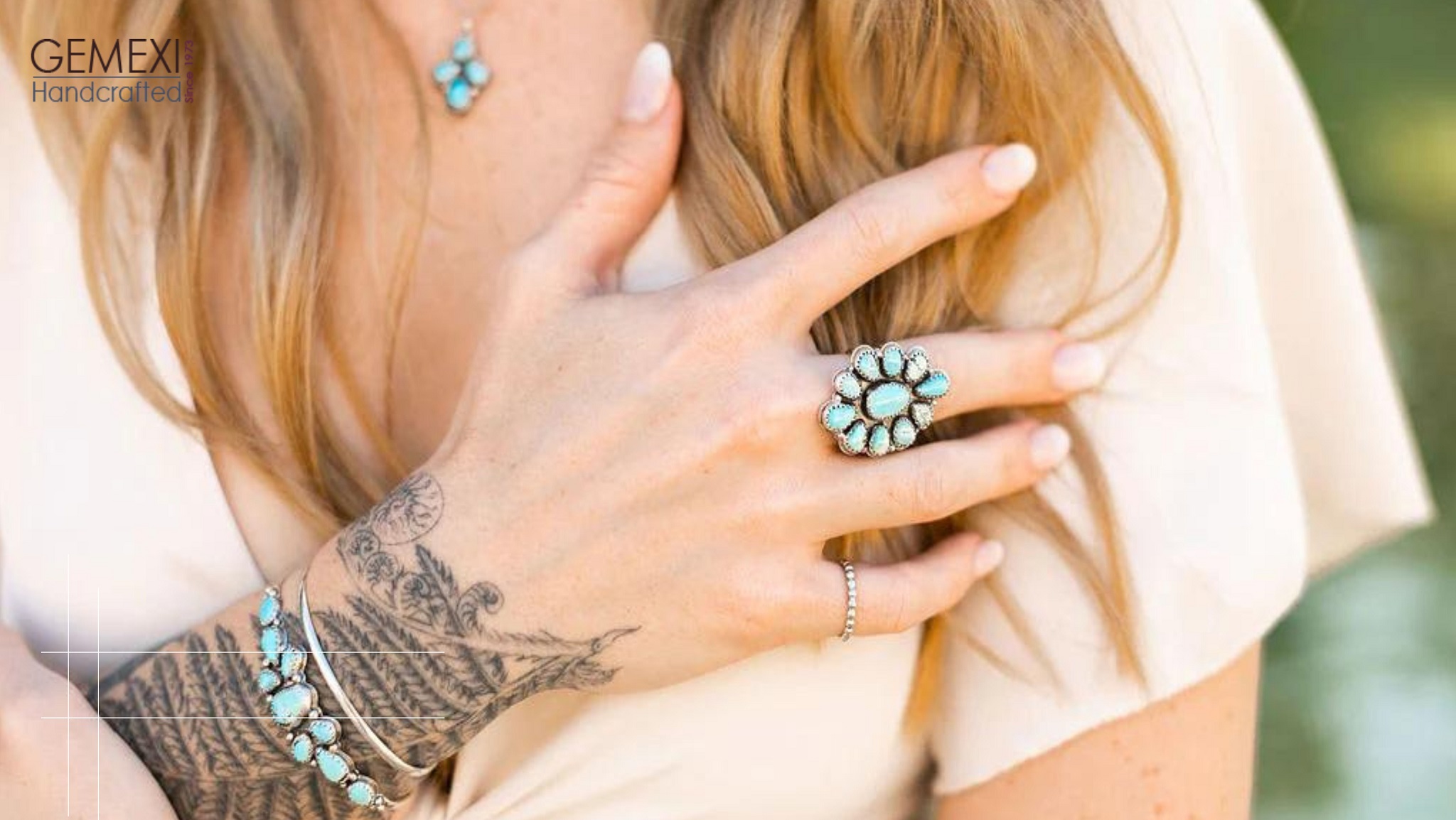Turquoise jewelry is loved for its vibrant blue-green hues and timeless appeal. Whether you’re wearing a statement necklace or delicate earrings, turquoise adds a touch of elegance to any outfit. But with the gemstone’s growing popularity, the market is flooded with imitations, making it harder to distinguish between real and fake. Authentic turquoise not only holds greater value but also has unmatched beauty. Here’s everything you need to know to determine whether your Sonora turquoise jewelry is genuine.
Understanding Turquoise
What Makes Turquoise Unique?
Turquoise is a semi-precious gemstone known for its rich colors and unique matrix patterns, formed over millions of years in arid climates. Its natural imperfections, combined with its vibrant hues, make every piece one of a kind.
Types of Turquoise
- Natural Turquoise: Untreated, straight from the earth, and highly valuable.
- Stabilized Turquoise: Treated to enhance durability and color but still genuine.
- Reconstituted Turquoise: Made from turquoise powder bonded with resin, often less valuable.
Common Imitations
Many fakes are made from dyed stones like howlite or synthetic materials like plastic. These imitations often lack the depth and texture of real turquoise.
Signs of Authentic Turquoise Jewelry
Natural Imperfections and Veining
Real South hill jewelry often features a matrix—vein-like patterns created by the surrounding rock. This natural characteristic is hard to replicate and a key sign of authenticity.
Weight and Density
Authentic turquoise feels heavier than its synthetic counterparts. Fakes, often made from plastic or resin, are lighter and less substantial.
Color Variations
Real turquoise comes in shades ranging from sky blue to greenish hues. If the color appears too uniform or overly vibrant, it’s likely fake.
How to Test Your Turquoise Jewelry
The Scratch Test
Genuine turquoise is relatively soft and can scratch with a knife or pin. Be cautious—this method is destructive and best reserved for unmounted stones.
Testing with Acetone
Dab a small amount of acetone (nail polish remover) on the stone. If the color rubs off, it’s likely a dyed imitation.
The UV Light Method
Stabilized turquoise glows slightly under UV light due to the resin used in its treatment. Natural turquoise will not show this effect.
Common Turquoise Imitations and How to Spot Them
Dyed Howlite and Magnesite
Howlite and magnesite are white stones that are often dyed to resemble Blackjack turquoise jewelry. Look for overly uniform veining and unnatural hues.
Plastic or Resin Turquoise
Fake turquoise made from plastic feels lighter and warmer to the touch. Tapping it gently produces a duller sound compared to real stone.
Reconstituted Turquoise
Reconstituted turquoise, made from turquoise powder mixed with resin, often shows unnatural patterns and a smoother texture.
Tips for Buying Authentic Turquoise Jewelry
Researching Reputable Sellers
Always buy from trusted jewelers or online stores with excellent reviews. Platforms like Etsy or specialty stores often provide artisan-crafted, genuine turquoise pieces.
Asking for Certificates of Authenticity
Certificates prove that the turquoise is genuine and untreated. High-quality pieces should come with this documentation.
Questions to Ask the Jeweler
- Is the turquoise natural, stabilized, or reconstituted?
- What is the origin of the turquoise?
- Does the piece come with a warranty or return policy?
Understanding Turquoise Pricing
Why Genuine Turquoise Costs More
Authentic turquoise is rare and labor-intensive to mine, contributing to its higher price.
Factors Influencing the Price
- Origin: Persian turquoise is often more valuable.
- Size and Quality: Larger, vibrant stones cost more.
- Craftsmanship: Handmade settings increase value.
Red Flags for Suspiciously Cheap Jewelry
If the price seems too good to be true, it probably is. Be wary of “turquoise” pieces that are surprisingly affordable, as they’re likely fake or low-quality.
Caring for Authentic Turquoise Jewelry
Proper Cleaning Methods
Authentic Number 8 Turquoise requires delicate care. Use a soft, damp cloth to gently clean the stone, avoiding harsh chemicals or abrasive cleaners. If the jewelry includes silver or gold, clean the metal separately to prevent damage to the turquoise.
Storing Turquoise to Maintain Its Quality
Store turquoise in a cool, dry place, away from direct sunlight and humidity, which can cause discoloration. Use soft fabric pouches or a lined jewelry box to prevent scratches and protect the stone’s surface.
Protecting It from Wear and Tear
Avoid exposing turquoise to water, lotions, or perfumes, as these can affect its color and texture. Always remove your turquoise jewelry before swimming, showering, or engaging in physical activities.
Why Real Turquoise Is Worth the Investment
Its Timeless Beauty and Unique Characteristics
Real turquoise offers unparalleled charm, with each stone boasting its own patterns and hues. Unlike mass-produced imitations, genuine turquoise exudes natural beauty that only improves with age.
Cultural and Historical Significance
Owning authentic turquoise connects you to centuries of tradition and cultural appreciation, from ancient civilizations to modern artisanship.
Higher Resale Value Compared to Imitations
While fake turquoise holds little to no resale value, authentic pieces can appreciate over time, especially when crafted into high-quality or designer jewelry.
The Role of Certification in Turquoise Jewelry
Why Certification Matters
A certificate of authenticity is your assurance that the turquoise is genuine and ethically sourced. It adds credibility and value to your purchase, particularly for high-end jewelry.
What a Certificate of Authenticity Includes
The certificate typically details the turquoise’s origin, treatment status (natural or stabilized), and any additional gemstones or materials used in the piece.
Where to Find Certified Turquoise Jewelry
Look for reputable jewelers or platforms that specialize in turquoise. Websites offering certified gemstones, such as Gemological Institute of America (GIA)-affiliated sellers, are reliable sources.
Conclusion
Authentic turquoise jewelry is more than just a fashion statement—it’s an investment in beauty, history, and individuality. By learning how to identify real turquoise, you ensure that your jewelry collection remains timeless and valuable. Whether you’re buying your first turquoise piece or expanding an existing collection, the effort to seek out genuine stones is always worth it. Embrace the allure of real turquoise and wear it with confidence, knowing its beauty and authenticity shine through.

